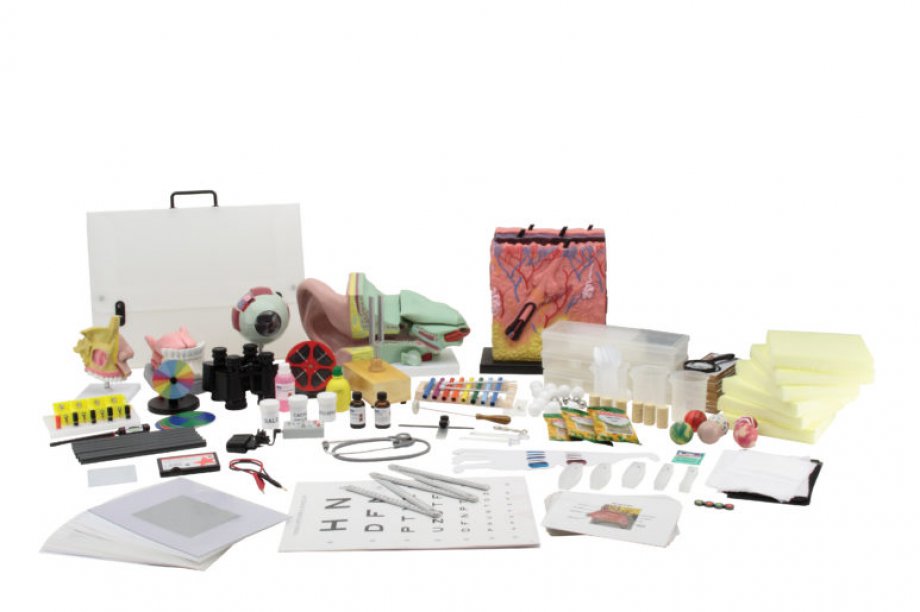5719 Exploring our senses
The sense organs are the instruments through which the body can receive and process the stimuli coming from outside. With the material provided in this collection teachers can enrich their lessons through the exhibition of sense organs’ models and conducting meaningful experiments, on physical and chemical stimuli. Even the students, divided into six working groups, can perform simple experiments through which:
– they acquire the knowledge that every sensation contributes to the perception of the outside world;
– they learn to distinguish the information coming from each sense;
– they learn the potentialities and limits of their sense organs and the hygienic standards for their correct use;
– they understand the importance of the connection between the sense organs and the brain in perception.
70 feasible experiments.
TOUCH
• The skin
• Skin’s sensibility
• Touch’s stimuli
• Pressure’s stimuli
• Pain’s stimuli
• Temperature & heat
• Thermal stimuli
• Hot and cold receptors
• To see through touch
• Fingerprints
• The skin’s hygiene
SIGHT
Light sources and illuminated bodies
Light propagation
Light transports energy
The eye: a light receiver
Lenses
The eye as an optical system
Eyes’ defects and their correction
Resolving power of the eye and visual acuity
The eye-brain system
The persistence of images on the retina
Temporal synthesis of colors
Spatial synthesis of colors
Binocular vision
Sense of depth
Stereoscopic vision
Field of view
Optical illusions
How to help the sight
NOTICE
To perform the experiments on eye and its defects, it is necessary to have a magnetic whiteboard because the pentalaser and the five lenses are magnetized.
the purchase of the whiteboard code 1329 is suggested, it can be hung on a wall or placed on a table.
OLFACTION
• What’s the matter like
• The matter’s aggregation stages
• Changes of state
• The nose: the organ of smell
• How smells are detected
• How smells are identified
• How we get used to smells
• The nose’s hygiene
TASTE
• The tongue and the taste buds
• How we taste different tastes
• The four main tastes
• Taste and olfaction
• Taste and sight
• Good and bad smells
HEARING
• Oscillating motion
• Graphical representation of the oscillating motion
• When we hear a sound
• Why we hear sounds
• Acoustic waves
• How acoustic waves turn into sounds
• The ear: a receiver of acoustic waves
• The ear-brain system
• The limits of audibility
• The distinctive features of sound
• The sensibility of auditory apparatus
• How to reinforce the auditory sensibility
• Stereo phonics
• Echo, reverberation and boom
• Cure of auditory apparatus
1 Linear ruler
6 Droppers
1 Tuning fork with case and small hammer
1 Vibrating plate
1 Stetoscope
1 Ultrasonic whistle
1 Xylophone
1 Electrical Newton disc
6 Stereoscopic glasses
2 Binoculars
6 Magnification lenses
1 Solar energy motor
1 Batteries-holder
2 Connection cables
6 Plastic tubes
1 Kit for the study of eyes and their defects
1 Ink pad
1 Kit of different items
6 Anti-acoustic pannels
1 Kit of different substances
1 Tastes’ kit
1 Punctured aluminum plate
1 Small sphere with wire
1 Digital thermometer
1 Model of eye
1 Model of ear
1 Model of skin
1 Model of nose
6 Petri dishes
3 Beakers 250 cc
6 Teaspoons
6 Tables on eye’s strucure
6 Tables on resolving power of the eye
1 Snellen chart
6 Tables on eye blind spot
6 Tables on images’ persistence
6 Tables on spatial synthesis of colours
6 Tables on visual axis convergence
6 Tables on visual axis convergence
6 Tables on chromatic optical illusions
6 Tables with Braille’s alphabet
6 Transparencies
6 Stereoscopic figures
1 Case
1 pdf teaching guide

